| year by year |
1953 - 1962
First generation Corvette...


|
1963 - 1967
Second generation Corvette...


|
1968 - 1982
Third generation Corvette...


|
1984 - 1996
Fourth generation Corvette...


|
1997 - 2004
Fifth generation Corvette...


|
2005 - Present
Sixth generation Corvette...


|
Future
Seventh generation Corvette...


|
 |
|
| |
1953 Corvette
|
In 1953 the original Corvette was introduced by Chevrolet (GM), but was really only intended to be part of the GM's Motorama exhibit at the New York Auto Show. It was built with parts "off the shelf" though, so, the reality of production would not take much more than a command decision by the Chevrolet management. The public embraced this new Corvette vehicle that they had seen, so production was given the green light, and the first Corvette (Serial Number E53F001001) rolled off the assembly line on June 30 of this year.
What else was happening in 1953? "The Wild One" outlaw biker film with Marlon Brando was out (see video clip at bottom of page). "Gentlemen Prefer Blondes" with Marilyn Monroe and Jane Russell hit the theaters. Dean Martin, Perry Como, and Hank Williams all had hit music singles that year. The real news though was the birth of a legend - The 1953 Corvette!
The 53 Vette basically had the suspension from the 52 sedan, a hopped up 150 hp 235 ci inline 6 (the "Blue Flame") , a two-speed automatic Powerglide transmission to handle the "massive power", and of course the modern fiberglass body. Contrary to the popular belief that fiberglass is a fragile and dangerous material in accidents, GM decided to go with this material because they accidentally rolled a prototype convertible in testing, in 1952, and were impressed how the body survived with little damage. 0-60 times were reported at around 11.5 sec.
This was an expensive vehicle for the times, far more expensive than GM had even anticipated, and it was produced at the Flint, Michigan assembly line which was in its infancy gearing up with this new model.
Buoyed by a wildly enthusiastic introduction as a concept car at GM's New York 1953 Motorama debut in January, company executives put production of the Corvette on a fast track to capitalize on the favorable public and media opinion. After months of frantic activity, production on the 1953 Corvette got underway, with the initial target set at just 50 cars a month -- a maximum of 300 units for the balance of the calendar year.
Actually, much of the 1953 model-year's run of 300 cars would be hand-built, as more-efficient production processes for assembling the vehicle's fiberglass body were still being perfected. All cars would be built the same way so workers could concentrate on putting the bodies together properly without being rushed and without the distraction of trim and equipment variations. As a result, all '53 Corvettes were painted Polo White and had Sportsman Red interiors, black tops, 6.70 X 15 four-ply whitewall tires, Delco signal-seeking radios, and recirculating hot-water heaters. Also standard was a complete set of analog instruments, including a 5000-rpm tachometer and a counter for total engine revolutions (a feature that would continue through 1959).
The first Corvette to come off the assembly line was driven by Tony Kleiber, a Chevrolet body assembler, on June 30, 1953 -- just six months after its public unveiling as a Motorama dream car. Amazingly, the first production Corvette was changed little from its concept display model. Some chrome-plated engine parts were now painted, manual doors and hood replaced the hydraulically operated versions, a manual choke was used instead of an automatic one, exterior door pushbuttons were left off, and there were some minor trim variations. Yet at a suggested retail price of $3,513, the car had evolved into a considerably costlier vehicle than the austere roadster Harley Earl had originally conceived as selling for around $2,000 as "Project Opel."
Though reaction to the Corvette as a show car was strongly positive, early reviews of the production version were mixed. For starters, sports-car enthusiasts took extreme umbrage to the vehicle's only available transmission, the Powerglide automatic. What's more, Harley Earl's body design, though clean and appealing, was still considered to be too gimmicky for some tastes. Coming under particular scrutiny in some quarters were the rocket-like rear fenders with their tiny fins, the dazzling vertical grille teeth, and the sunken headlights covered by mesh stone guards. The shadow-box license-plate housing was covered by plastic that tended to turn cloudy.
The car's convertible top was not power operated, but it folded neatly beneath a flush-fitting cover and could be managed with some ease by one person. The clip-in side curtains, perhaps favored over roll-down windows as a cost-cutting measure, were every bit as inconvenient and annoying as they were on the less-expensive British roadsters of the period. Even worse, not having exterior door buttons meant that the only way to open a door from the outside was to reach inside the car for the release.
Performance-wise, however, the Corvette was quite a good sports car. Even with Powerglide and the six-cylinder engine, a well-tuned example could do 0-60 mph in 11 seconds and reach 105 mph flat out, which was commendable at the time. Furthermore, road testers from contemporary enthusiast magazines judged the ride/handling balance to be excellent.
Unfortunately, for all the demand the Motorama car had generated, neither consumers nor dealers could as yet obtain one. Early production models went to project engineers for testing and engineering purposes (production cars 001001 and 001002 are believed to have been destroyed), and the balance went to GM managers and other visible people. Word was released that the year's entire contemplated production had already been spoken for. That was a nice way of saying that Chevy didn't really intend to sell Corvettes to the general public, at least not just yet. Indeed, a dealer notice issued by the division's Central Office on July 10 cautioned that, "No dealer is in a position to accept firm orders for delivery of a Corvette in 1953." In fact, Chevrolet couldn't begin addressing customers' orders until a new plant would subsequently be geared up for '54 production.
|
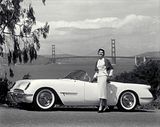

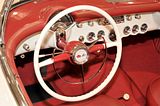
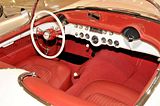

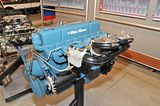
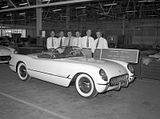


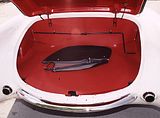

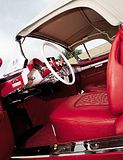

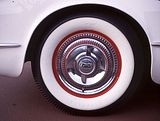
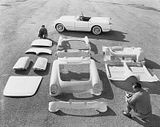
Corvette's fiberglass body comprised 46 pieces glued together to form
the nine major subassemblies.

|
1953 Corvette Manufacturing and Marketing
For the 1953 Corvette, Chevrolet was in effect employing what we'd now call a "controlled production start-up" by not releasing the car for sale to the general public. This plan made sense, all things considered. Given the company's lack of experience with fiberglass manufacturing techniques, the quality of the finished product was very much in doubt. And GM definitely did not want to risk embarrassment should something go wrong with new cars in the dealer pipeline, especially with a brand new "image" car that had already attracted so much attention.
It was just as well, because quality problems surfaced early. Predictably enough, they involved the fiberglass body. Each body began as 46 separate pieces that were supplied by the Molded Fiber Glass Company of Ashtabula, Ohio. Workers had to fit all these into wooden jigs, then glue them together into the larger subassemblies, all of which took time and left vast room for error. Worse, some pieces didn't fit together well as delivered because of molding flaws that required still more hand labor to correct.
As a result, the fit-and-finish of early Corvette bodies was variable to say the least, with judgments on the fiberglass ranging from fair to excellent compared to steel construction. What's more, creaks and groans as well as drumming from the fiberglass body structure plagued the new vehicles -- as they would on most every Corvette built through 1962.
In the fall of 1953 as a promotional endeavor, Chevrolet began to use the first available production cars as dealer-display attractions. Each of the eight Chevrolet wholesale regions was assigned a car to send from dealer to dealer for one- to three-day showings during the last three months of the year. In an effort to enhance the Corvette's image as a prestige car, dealers restricted sales to VIPs in each community: mayors, celebrities, industrial leaders, and favorite customers. The Corvette was glamorous and exciting, especially compared to the rest of the company's more-mundane passenger-car line, and Chevrolet's publicists played it up for all it was worth.
Coming on the heels of the big pre-launch buildup, this public-relations maneuver had an unintended effect. With ads and stories about the car appearing everywhere but no vehicles being genuinely available, some began to wonder whether Chevy was pulling a fast one. While it’s common today for limited-production models to sell out before their release, with potential buyers paing a premium to get on the waiting list, this type of product launch was unheard of in the early 1950s. Some wondered if this “dream car” was still just a dream after all.
Chevy's marketing plan backfired in a big way. While the company's judgment was fundamentally sound in turning to VIPs as opinion leaders, unfortunately these folks didn't end up liking the car as much as the marketers had hoped. Many complained of the "jet-age" styling, clumsy side curtains, off-the-rack mechanicals, and the vehicle's high price. British sports-car partisans condemned the Corvette as being nonfunctional and faddish. Potential buyers went looking at MGs, Jaguars, and Triumphs, instead.
Production for the 1954 models was shifted to a renovated St. Louis assembly plant in December 1953, which was designed to build more than 10,000 Corvettes a year (the first 14 or 15 '54 models were actually built in Flint, however, as were all engines). Finally, anyone who wanted and could afford a Corvette could readily find one in stock at their local Chevy store.
|
|
This is the very first Corvette ever built Corvette No.1. The above picture shows the first American Super Car to rolling off the assembly line on June 30,1953. All of the first 15 1953 Corvettes were all built by hand in a customer delivery garage in Flint Michigan before the new automobile plant that was devoted to producing the Corvette began production in St. Louis. This new automobile plant was capable of building 10,000 Corvettes a year but only created 300 in the first year. Of those 300 cars created the first two were test cars and were destroyed, but approximately 225 of the 1953 Corvettes are known to still exist today.
In 1953 there weren’t many options on the Corvette, actually there were only two an Am radio for $145.15 and a heater that would run you $91.40. But in all reality even though they were listed as options all 1953 Corvettes were equipped with both options.
So back in 1953 if you bought one of these fully loaded Polo White with red interior and a black canvas top (that is the only way they came) you would have had to shell out $3,498.00 to own this first American Super Car. |


|
| #1 at the GM Motorama |

|
1953 Corvette Specifications
The 1953 Corvette featured an innovative fiberglass body that made for a much lighter car, which could be more easily molded into complex shapes than traditional steel construction vehicles. Despite some initial production problems, the car was a strong performer. Here are the specifications for the 1953 Corvette:
Vehicle Specifications
|
Convertible
|
| Wheelbase, inches |
102.0
|
Length, inches
|
167.0 |
Width, inches
|
72.2
|
Track, inches
|
front: 57.0 rear: 59.0
|
Height, inches
|
51.3
|
Curb Weight, pounds
|
2,850 |
Mechanical Specifications (2-door convertible)
Suspension
front:Independent; upper and lower A-arms, coil springs, antiroll bar, tubular hydraulic shock absorbers
rear: Live axle on semi-elliptic leaf springs, tubular hydraulic shock absorbers
Wheels/Tires
6.0x15
Brakes
front: 11-inch drum
rear: 11-inch drum
Transmission
2-speed Powerglide
Standard axle ratio
3.55:1
Engine Specifications
| Type |
ohv I-6 |
| Displacement, liters/cu inch |
3.85/235.5
|
| Bore x stroke, inches |
3.56 x 3.95 |
| Fuel Management |
3 Carter sidedraft
|
| Horsepower @ rpm |
150 @ 4200 |
| Torque @ rpm, pound-foot |
223 @ 2400 |
Published Performance Numbers
Acceleration
|
150 hp, 2-sp automatic
|
0-60 mph, sec
|
11.0
|
0-100 mph, sec
|
41.0
|
1/4-mile, sec
|
17.9
|
Source: Road & Track
Vehicle Production and Base Prices
Car Type
|
Production
|
Price
|
2-door convertible
|
300
|
$3,498.00
|
Options and Production
Option
|
Production
|
Price
|
AM radio, signal seeking
|
300
|
$145.15
|
Heater
|
300
|
91.40
|
Color Choices and Production
Color Choice
|
Production |
Polo White
|
300 |
|
|
|
|